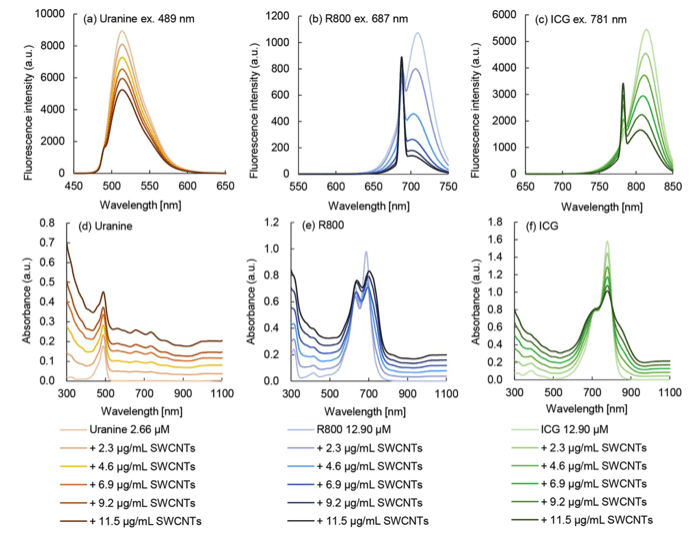
Carbon nanotubes (CNTs) and their detail structures were observed by a Japanese physicist somewhat accidentally and now are attracting thousands of researchers’ interests. They have potential to bring revolution to electronics, mechanics, and even medical sciences.
The point is their unique structures. As expressed in the name, they are very fine tubes consisting of carbon five-membered rings, which is often referred as “quasi-” one-dimensional. They are strong like diamonds, highly electro-conductive like copper but sometimes behave like semiconductors. These are a few of the reasons why they are regarded as promising materials in vast fields of science.
On the other hand, DNA seems to be a purely biological research object. However, as known well, it was a physical technic called X-ray diffraction that determined the structure of DNA molecule. Who could predict DNA and CNTs, such different materials, would be combined? In fact, they literally combine with each other and result in so-called DNA-CNT hybrids.
Originally, there were a series of researches which tried to solve CNTs in water or other solutions. Roughly saying, CNTs are powder of carbons. Each tube tightly binds each other and cannot be solved nor dispersed as it is. Surfactants, for example, were reasonable candidates as “dispersant” of CNTs. Imagine a washing machine and stains and smudges being removed from clothing. That is the power of surfactants. This situation can be realized in a laboratory. One mixes CNT powder and optimal dispersants such as surfactants in a solution in a test tube and exerts ultrasonic wave on it instead of throwing it into a washing machine. After a while, one sees CNTs are dispersed in a solution. In the solution, seeing microscopically, on the surfaces of CNTs are attached surfactants molecules.
In this context, DNA was used as a dispersant and combined with CNTs to be DNA-CNT hybrids. Why DNA? Many organic molecules are known to be able to work as CNT dispersants. Such molecules include polymers, dyes, and proteins. These molecules not only disperse CNTs but also impart their chemical or physical properties to CNTs, which makes resulting hybrids so unique. Nowadays, DNA is no longer purely biological production but artificial materials. We can produce arbitrarily sequenced DNA molecules with arbitrary length to a certain accuracy. Since CNTs show different reactions to DNA of different sequence, we may be able to control complicated molecular recognition dynamics by controlling DNA sequences. “Wrapping” CNT with DNA molecule is thus a fascinating idea. The appearance of dispersed CNTs is shown in Figure 1.

Figure 1: CNTs dispersed by DNA observed by atomic force microscopy (Republished with permission from Analytical Biochemistry)
Fluorescent dyes are also candidates as a dispersant. One can find them in highlighter pens. They are molecules that absorb and emit light. A significant fact is that dyes lost their ability to emit light on the surface of CNT. This is called “quenching.” Utilizing this property, dyes can be tiny sensors or switches which recognize molecular behaviors. A combination of DNA-CNT hybrids and dyes are also interesting. Since DNA-CNT hybrids are stable, they can be a kind of scaffold for dye molecules. In terms of drug delivery, they work as molecular vehicles.

Figure 2: Fluorescence/absorbance spectra of dyes with DNA-CNT hybrids (Republished with permission from Analytical Biochemistry)
Figure 2 shows results of attempts to attach different kinds of dyes onto the surface of DNA-CNT hybrids, expecting these hybrids work as scaffolds. In the experiments, the concentration of DNA-CNT hybrids in solutions were well-controlled and absorbance and fluorescence of light by dyes are examined. A different manner of changes in the shapes of spectra shows different behavior of dyes.
In all the cases, quenching was observed, which showed DNA-CNT hybrids worked as scaffolds. One can utilize various kinds of dyes regardless of their hydrophobicity or instability in solutions by deploying DNA-CNT hybrids so that various wavelengths of fluorescence are possible options.
These findings are described in the article entitled A convenient method of attaching fluorescent dyes on single-walled carbon nanotubes pre-wrapped with DNA molecules, recently published in the journal Analytical Biochemistry. This work was conducted by Akihiro Tomura and Kazuo Umemura from the Tokyo University of Science.








